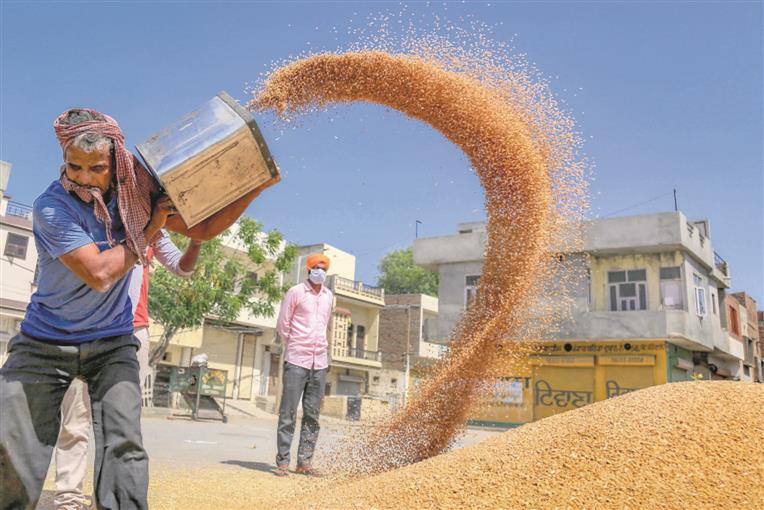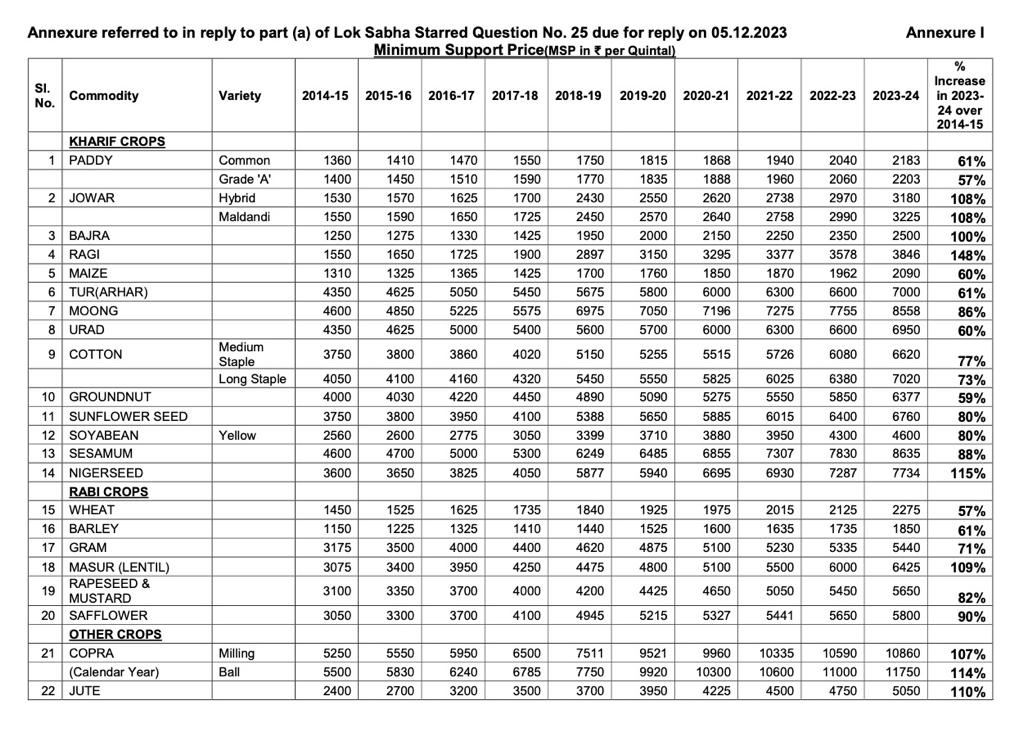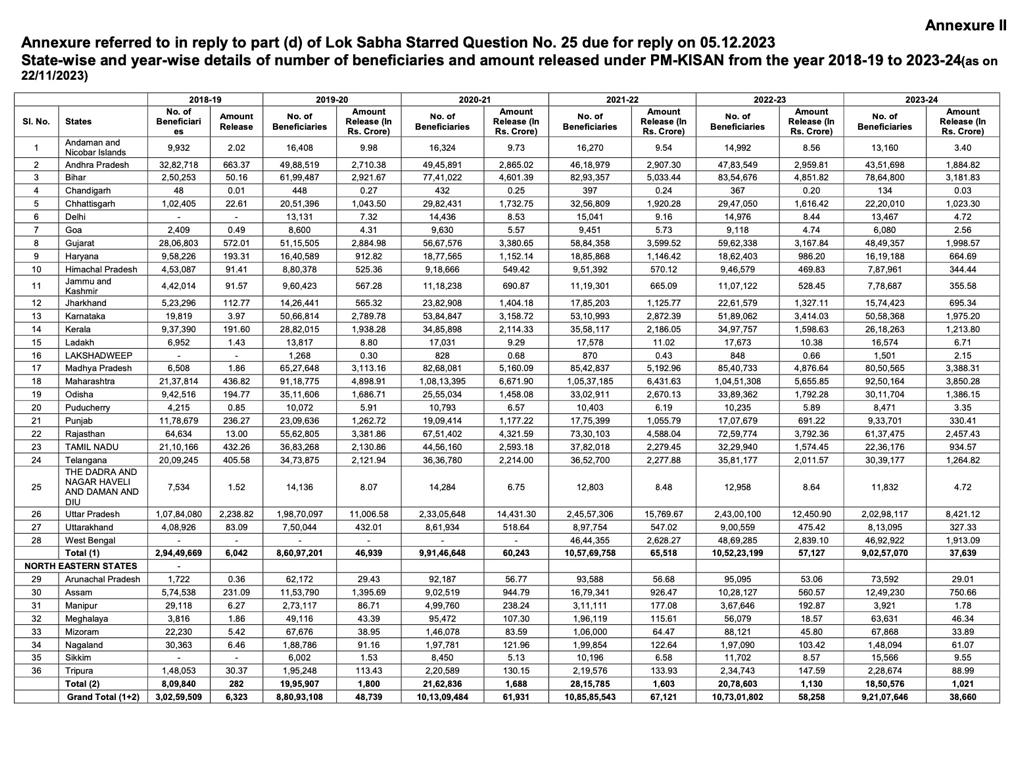On December 5, during the on-going winter parliamentary session, Dr. Manoj Rajoria and Shrimati Ranjeeta Koli raised questions regarding the Minimum Support Price of crops as well as about the Pradhan Mantri Kisan Samman Nidhi (PM-KISAN) in Lok Sabha. Dr. Manoj is a member of parliament of Lok Sabha from the Karauli – Dholpur Constituency in Rajasthan and Ranjeeta Koli is a member of parliament of Lok Sabha from the Bharatpur constituency in Rajasthan. The questions raised were regarding the steps taken by the government to help the farmers by formulating any scheme to further increase the amount of Pradhan Mantri Kisan Samman Nidhi (PM-KISAN) from Rs. 6000. The question further asked to know the total funds spent and number of beneficiaries of the said scheme.
Narendra Singh Tomar, the minister of Agriculture and Farmer’s Welfare and a member of parliament of Lok Sabha from the Morena constituency in Madhya Pradesh, responded to the said questions. The data provided showed the increase in MSP through the years of 2014 to 2023. A close look at the data shows that even though a gradual increase in the prices of the commodities can be seen, the percentage of increase has been fluctuating. For example, in the case of Paddy crop, the price increased from 1550 in 2017-18 to 1750 in 2018-19 resulted in a 12.9 % increase in price. But, the percentage of increase comes down to 7% later, when the price of the crop increases from 2040 in 2022-23 to 2183 in 2023-24. Thus, it is crucial to note the fluctuations in percentage increase alongside the raw prices of the crops every year.
The response from the union government also highlighted that at present, there were no proposals being considered to further increase the amount of MSP from Rs. 6000. The said revelation cannot be deemed to be anything less than unfair in comparison to the increasing inflation rate. It is essential to highlight here that in the year 2018, when the same amount of Rs. 6000 was given to the farmers as MSP, the inflation rate was 3.94%. On the other hand, in 2022, while the inflation rate has increased to 6.7%, the same amount of MSP is being provided. Considering that the aim of the scheme is to provide financial assistance to all farmer families across the country and to enable them to take care of expenses related to agriculture and allied activities as well as domestic needs, an urgent need to increase the amount of MSP is essential.
The response also provides the details of the number of beneficiaries and the amount released under PM-KISAN from 2018-19 to 2023-24. Based on the data, it can be observed that the 28 states see a gradual increase in the number of beneficiaries between the years 2018 to 2022, post which there has been a decrease in the number of beneficiaries in 2022-23. The PM-KISAN scheme, despite disbursing a substantial amount over multiple instalments to more than 11 Crore farmers, faces scrutiny over its sustainability and adequacy. The revelation of declining beneficiary numbers post 2021-22, following an unprecedented hike in expenditure in 2019-20, raises pertinent questions about its long-term effectiveness.
While the government has consistently increased MSP for various crops, the percentage increase has fluctuated significantly over the years, prompting concerns about the efficacy of these adjustments. The procurement of food grains has surged, benefitting millions of farmers, yet concerns linger regarding the variability in percentage hikes despite increased expenditures. In addition to this, the disparity between rising inflation rates and the static financial assistance provided to farmers remains a focal point. The aim to assist agricultural activities and domestic needs requires revisiting the fixed amount in alignment with the country’s inflation trends.
Overall, this question and the data made available in the Lok Sabha emphasized the need for a thorough review of farmer support schemes like PM-KISAN, urging considerations for adjustments to accommodate inflation and ensure consistent aid to the farming community.
The complete answer can be read here:
Related:
Infant mortality rate: UP records highest rate for SC at 57.8, Chhattisgarh at 41.6 for ST
MOE: Alarming dropout rates among SC, ST, and OBC students in premium institutes of India since 2018
Displacement due to Airport Expansions? Union Response in Rajya Sabha Leaves Questions Unanswered
Union government data shows increasing employment, decreasing unemployment rate since 2018
Union data shows increasing beneficiaries of scholarships for OBCs in the past 5 years
Over 5 years, 1033 serious coal accidents reported, 717 took place in Telangana alone



